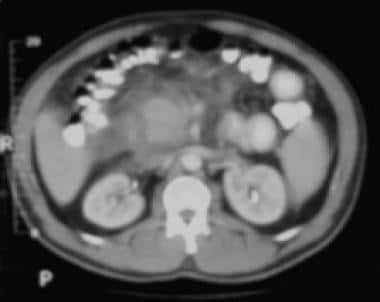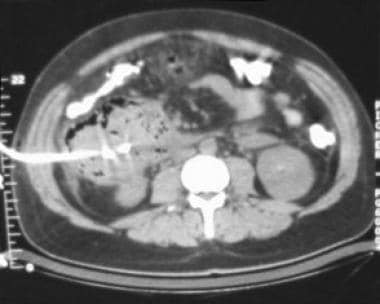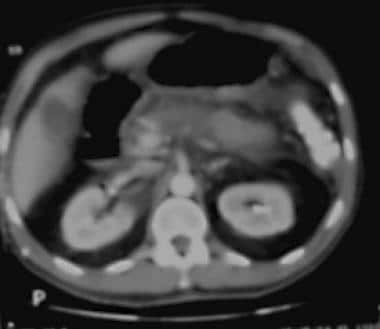Overview
According to the revised Atlanta Classification, 2 out of 3 features are required for diagnosing acute pancreatitis: (1) acute-onset upper abdominal pain radiating to the back; (2) serum lipase or amylase levels 3 or more times higher than the normal range; and (3) classical imaging findings consistent with acute pancreatitis
.
The revised Atlanta Classification divides acute pancreatitis into 3 grades: mild, moderately severe, and severe acute pancreatitis, as follows
:
Mild: lacks organ failure; locoregional as well as systemic complications. The episode resolves itself within a week, mortality is rare, and pancreatic imaging is often not required.
Moderately severe: distinguished by the presence of transient organ failure, locoregional as well as systemic complications, and/or transient organ failure. Morbidity and mortality are greater than those of mild acute pancreatitis. The event usually does not last more than 2–3 weeks.
Severe: characterized by persistent organ failure and locoregional as well as systemic complications. Patients with severe acute pancreatitis that develops within the early phase have a higher mortality (36–50%). Development of infected necrosis carries a grave prognosis.
Acute pancreatitis. Focal pancreatitis involving pancreatic head. Pancreatic head is enlarged with adjacent ill-defined peripancreatic inflammation and fluid collections.
Local complications of acute pancreatitis include fluid collections, pseudocyst formation, abscess, pancreatic necrosis, hemorrhage, venous thrombosis, and pseudoaneurysm formation (see the images below).
A pseudocyst is defined as a collection of pancreatic juice enclosed by a wall of fibrous or granulation tissue. A pseudocyst lacks a true epithelial lining and often communicates with the pancreatic duct. A pancreatic abscess is a circumscribed intra-abdominal collection of pus. The development of both pseudocyst and abscess usually requires 4 or more weeks from the initial clinical onset of acute pancreatitis.
Pancreatic necrosis is defined as focal or diffuse areas of nonviable pancreatic parenchyma; it usually is associated with peripancreatic fat necrosis. Necrosis usually develops early in the course of acute pancreatitis.
Acute pancreatitis. Pancreatic abscess. Large, relatively well-circumscribed heterogeneous collection containing gas bubbles inferior to the pancreatic head. This collection was drained successfully and percutaneously via a 12Fr pigtail catheter.
Acute pancreatitis. Pancreatic necrosis. Note the nonenhancing pancreatic body anterior to the splenic vein. Also present is peripancreatic fluid extending anteriorly from the pancreatic head.
Acute pancreatitis. Pancreatic necrosis. Approximately 50% of the pancreatic gland does not display enhancement after contrast administration.
Gallstones and alcohol abuse are the most common causes of acute pancreatitis, accounting for 60-80% of cases. Other causes include blunt trauma to the abdomen, iatrogenic trauma (postoperative trauma, endoscopic retrograde cholangiopancreatography), hypertriglyceridemia, hypercalcemia, drug-induced, infectious etiologies (eg, mumps, cytomegalovirus), congenital anomalies (pancreas divisum, choledochocele), ampullary or pancreatic tumors, vascular abnormalities (atherosclerotic emboli, hypoperfusion, vasculitis), cystic fibrosis, and Reye syndrome. These miscellaneous causes account for approximately 10% of cases of acute pancreatitis. In approximately 10-25% of patients, no underlying cause is found.
Preferred examination
Contrast-enhanced computed tomography (CECT) is the standard imaging modality for the evaluation of acute pancreatitis and its complications.
Using non–contrast-enhanced CT, clinicians can establish the diagnosis and demonstrate fluid collections but cannot evaluate for pancreatic necrosis or vascular complications.
CECT allows complete visualization of the pancreas and retroperitoneum, even in the setting of ileus or overlying bandages from a recent surgical procedure. CECT can help detect almost all major abdominal complications of acute pancreatitis, such as fluid collections, pseudocysts, abscesses, venous thrombosis, and pseudoaneurysms. In addition, CECT can be used to guide percutaneous/interventional procedures such as diagnostic fine-needle aspiration or catheter placement. CECT may be performed on severely ill patients including intubated patients. Lastly, CECT can be used as a prognostic indicator of the severity of acute pancreatitis.
Other adjunctive imaging modalities include ultrasonography (US), MRI, and angiography. US is especially useful in the diagnosis of gallstones and follow-up observation of pseudocysts. US also can be used to detect pancreatic pseudoaneurysms.
The diagnostic efficacy of MRI is comparable to that of CECT, although MRI examination is more time consuming and costly.
Angiography is primarily used to help diagnose the vascular complications of acute pancreatitis.
CT and US are the guidance modalities of choice in performing diagnostic fine-needle aspiration and percutaneous drainage of fluid collections. Diagnostic fine-needle aspiration is performed to distinguish infected from noninfected pseudocysts and to delineate pancreatic abscess from infected necrosis. The aspirate should be sent at once for Gram stain and subsequent aerobic, anaerobic, and fungal cultures. Treatment regimens for these entities differ.
Limitations of techniques
The usefulness of CECT is limited in patients who are allergic to intravenous (IV) contrast or have renal insufficiency. Patients who have severe acute pancreatitis often require multiple scans to assess progress and/or complications. This necessitates significant radiation doses.
In addition, CECT is far less sensitive than US in detecting gallstones or biliary duct stones, a common cause of acute pancreatitis. Therefore, if gallstones or an impacted common bile duct stone is not seen on CT, US is necessary to document the presence or absence of gallstones.




